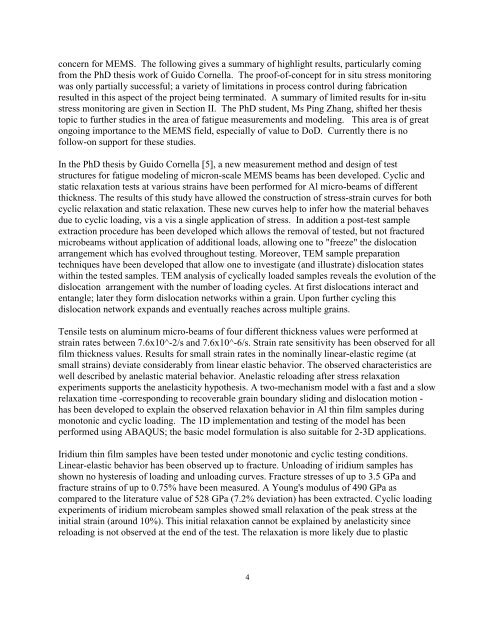Advanced CAD System for Electromagnetic MEMS Interactive Analysis
Advanced CAD System for Electromagnetic MEMS Interactive Analysis
Advanced CAD System for Electromagnetic MEMS Interactive Analysis
Create successful ePaper yourself
Turn your PDF publications into a flip-book with our unique Google optimized e-Paper software.
concern <strong>for</strong> <strong>MEMS</strong>. The following gives a summary of highlight results, particularly coming<br />
from the PhD thesis work of Guido Cornella. The proof-of-concept <strong>for</strong> in situ stress monitoring<br />
was only partially successful; a variety of limitations in process control during fabrication<br />
resulted in this aspect of the project being terminated. A summary of limited results <strong>for</strong> in-situ<br />
stress monitoring are given in Section II. The PhD student, Ms Ping Zhang, shifted her thesis<br />
topic to further studies in the area of fatigue measurements and modeling. This area is of great<br />
ongoing importance to the <strong>MEMS</strong> field, especially of value to DoD. Currently there is no<br />
follow-on support <strong>for</strong> these studies.<br />
In the PhD thesis by Guido Cornella [5], a new measurement method and design of test<br />
structures <strong>for</strong> fatigue modeling of micron-scale <strong>MEMS</strong> beams has been developed. Cyclic and<br />
static relaxation tests at various strains have been per<strong>for</strong>med <strong>for</strong> Al micro-beams of different<br />
thickness. The results of this study have allowed the construction of stress-strain curves <strong>for</strong> both<br />
cyclic relaxation and static relaxation. These new curves help to infer how the material behaves<br />
due to cyclic loading, vis a vis a single application of stress. In addition a post-test sample<br />
extraction procedure has been developed which allows the removal of tested, but not fractured<br />
microbeams without application of additional loads, allowing one to "freeze" the dislocation<br />
arrangement which has evolved throughout testing. Moreover, TEM sample preparation<br />
techniques have been developed that allow one to investigate (and illustrate) dislocation states<br />
within the tested samples. TEM analysis of cyclically loaded samples reveals the evolution of the<br />
dislocation arrangement with the number of loading cycles. At first dislocations interact and<br />
entangle; later they <strong>for</strong>m dislocation networks within a grain. Upon further cycling this<br />
dislocation network expands and eventually reaches across multiple grains.<br />
Tensile tests on aluminum micro-beams of four different thickness values were per<strong>for</strong>med at<br />
strain rates between 7.6x10^-2/s and 7.6x10^-6/s. Strain rate sensitivity has been observed <strong>for</strong> all<br />
film thickness values. Results <strong>for</strong> small strain rates in the nominally linear-elastic regime (at<br />
small strains) deviate considerably from linear elastic behavior. The observed characteristics are<br />
well described by anelastic material behavior. Anelastic reloading after stress relaxation<br />
experiments supports the anelasticity hypothesis. A two-mechanism model with a fast and a slow<br />
relaxation time -corresponding to recoverable grain boundary sliding and dislocation motion -<br />
has been developed to explain the observed relaxation behavior in Al thin film samples during<br />
monotonic and cyclic loading. The 1D implementation and testing of the model has been<br />
per<strong>for</strong>med using ABAQUS; the basic model <strong>for</strong>mulation is also suitable <strong>for</strong> 2-3D applications.<br />
Iridium thin film samples have been tested under monotonic and cyclic testing conditions.<br />
Linear-elastic behavior has been observed up to fracture. Unloading of iridium samples has<br />
shown no hysteresis of loading and unloading curves. Fracture stresses of up to 3.5 GPa and<br />
fracture strains of up to 0.75% have been measured. A Young's modulus of 490 GPa as<br />
compared to the literature value of 528 GPa (7.2% deviation) has been extracted. Cyclic loading<br />
experiments of iridium microbeam samples showed small relaxation of the peak stress at the<br />
initial strain (around 10%). This initial relaxation cannot be explained by anelasticity since<br />
reloading is not observed at the end of the test. The relaxation is more likely due to plastic<br />
4
















